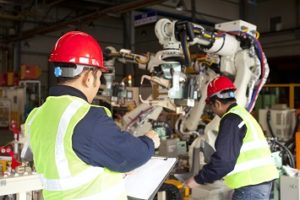Small and medium enterprises (SMEs) have yet to embrace robotics on a large scale—perhaps because modern industrial robots are best suited to larger, higher-volume operations. The dynamic, small-batch production environment of SMEs require a skill set robots have not, in the past, possessed: the ability to work collaboratively with humans and with other robots. But “collaborative robot systems” are no longer entirely a thing of science fiction: robots are increasingly able to coordinate, communicate, and understand their actions, roles, and task status.

ndoeljindoel / iStock / Getty Images Plus / Getty Images
The ability to better sense, assess, and react to their environments and to changing job tasks doesn’t make them artificially intelligent—at least, not yet. However, it does mean that they can take on more complex tasks and interact more directly with human workers. So perhaps it’s time to begin teaching our mechanical helpers the first law of robotics set down by science fiction writer Isaac Asimov in his 1942 short story, “Roundabout:” “A robot may not injure a human being or, through inaction, allow a human being to come to harm.”
Rules for Robots
There are no OSHA standards that directly address robot hazards, but there are consensus safety standards that have been developed with collaborative robot systems in mind: ANSI/RIA R15.06-2012, Industrial Robots and Robot Systems—Safety Requirements, and ISO 10218:2011, Robots and Robotic Devices—Safety Requirements for Industrial Robots. Some of the technologies and features that are intended to help these new robots work safely alongside humans include:
Force-limited applications. If the task the robot is performing cannot injure a human, it is safe for the human and the robot to work alongside one another. The ISO standard includes technical specifications that define the power- and force-limits that are compatible with collaborative work. Robots can also be equipped with torque-sensing devices that identify increases in the torque or force required to perform a task, and that will shut the robot down if it senses such an increase.
Speed and separation monitoring. Presence-sensing devices can be used on mobile robots to ensure that they maintain a minimum separation between themselves and humans. Limiting the speed of mobile robots and improving their motion control and sensing capabilities can also help to enable robots and people to work together safety.
Safe design. Design features that make robots safer in contact with humans include the elimination of sharp edges, hot surfaces, and potentially hazardous protruding parts; the use of materials that soften any incidental contact; the use of back-drivable joints; and the elimination of pinch points.
Collision detection systems. Impedance technology can enable robots to identify unanticipated contact with people or objects, and flexible joint actuators enable the robot to soften its joints so that the robot can be easily pushed away.
With new technologies and safety features, collaborative robot systems may soon be working outside their protective cages, as fully integrated members of your manufacturing team.
